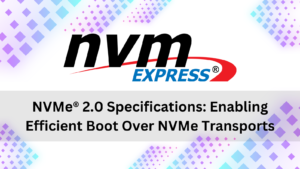
NVMe® 2.0 Specifications: Enabling Efficient Boot Over NVMe Transports
BlogDoug Farley, Dell, Phil Cayton, Intel, and Rob Davis, NVIDIA – Co-Chairs of the NVMe Boot Task Group
A standardized boot solution is vital for building efficient, stable, large-scale network storage deployments. iSCSI and Fibre Channel feature standardized boot solutions that enable computer systems to boot from local systems or remotely across a fabric. We saw the need to include a standardized boot specification within the NVMe® specs and developed the NVM Express® Boot Specification [nvmexpress.org], which enables network infrastructure markets to experience improved stability and consistent functionality for future NVMe transports.
Introducing the NVM Express Boot Specification
By developing the new NVM Express Boot Specification, we are able to expand the existing NVMe specifications to include functionality for booting from local and remote namespaces across NVMe transports. Currently, the specification defines procedures for booting on an NVMe over TCP transport [youtube.com] and includes planned updates for booting across additional transports. The NVM Express Boot Specification offers performance and security benefits across numerous industries, including data centers, high-performance computing and cloud infrastructure markets.
Vital Benefits and Use Cases for Hyperscalers and Enterprise Organizations
The NVM Express Boot Specification allows the establishment of composable disaggregated infrastructures with limited hardware and software resources. Data centers and enterprise organizations can establish servers with a remote boot drive connected through low-latency, high-speed networks that are capable of booting across the network. This eliminates the need to store OS images throughout the network and reduces the necessary hardware and software resources on the server.
The spec also enables quick recovery of a network infrastructure following a network shutdown from a natural or unexpected disaster. By utilizing the remote boot functionality, data centers and cloud infrastructure markets can boot a system from any remote OS image stored across the network, reestablishing their network infrastructure and ensuring continued service for their customers.
Industry Partnerships and Ecosystem
The development of the NVM Express Boot Spec is made possible through collaboration with our ecosystem and industry partners. The addition of the UEFI Forum [uefi.org] and DMTF [dmtf.org] has helped to include essential standardization tools for the creation of the spec. Furthermore, by including the public reference implementation [github.com], we have been able to base the development of the specification on an open-source framework.
Join the NVM Express Boot Specification Task Group and Learn More
The NVM Express Boot Specification Task Group is comprised of numerous NVM Express member companies each dedicated to delivering updates to the NVM Express Boot Specification. If you’re an NVM Express member interested in getting involved, join the task group on Causeway [workspace.nvmexpress.org].
Visit the NVM Express website [nvmexpress.org] to download the NVM Express Boot Specification and learn more.